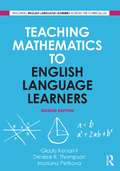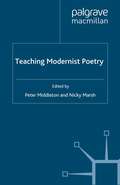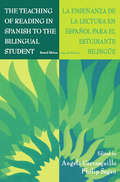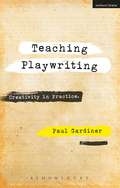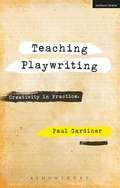- Table View
- List View
Teaching Literature Using Dialogic Literary Argumentation
by Matt Seymour Theresa Thanos George E. Newell David BloomeIntroducing a new framework for teaching and learning literature in secondary schools, this book presents Dialogic Literary Argumentation as an inquiry-based approach to engage students in communicating and exploring ideas about literature. As a process of discovery, Dialogic Literary Argumentation facilitates conversation—"arguing-to-learn"—as a method to support students’ diverse perspectives and engagement with one another in order to develop individual and collective understandings of literature and their place in the world. Covering both the theoretical foundation and application of this method, this book demonstrates how to apply Dialogic Literary Argumentation to teach literature in a way that foregrounds dialogue, learning through inquiry, diverse views, listening to others, and engagement with our communities. Ideal for preservice teachers in literacy methods courses and practicing teachers, it features real-world cases, discussions of the principles presented, resource lists, and conversation starters for professional learning communities, professional development, and teacher education.
Teaching Lives: Contemporary Pedagogies of Life Narratives
by Laurie McNeill Kate DouglasThe contemporary ‘boom’ in the publication and consumption of auto/biographical representation has made life narratives a popular and compelling subject for twenty-first century classrooms. The proliferation of forms, media, terminologies, and disciplinary approaches in a range of educational contexts invites discussion of how and why we teach these materials. Drawing on their experiences in disciplines including creative writing, language studies, education, literary studies, linguistics, and psychology, contributors to this volume explore some of the central issues that inspire, enable, and complicate the teaching of life writing subjects and texts, examining the ideologies, issues, methods, and practices that underpin contemporary pedagogies of auto/biography. The collection acknowledges the potential perils that life writing texts and subjects represent for instructors, with a series of short essays by leading auto/biography scholars who reflect on their failed experiences teaching life narratives, and share strategies for negotiating the particular challenges these texts can present. Exploring issues including teaching across genres, analyzing writing about trauma, decolonizing pedagogies, and challenging assumptions (our own, our students’, and our colleagues’), Teaching Lives illuminates what makes the teaching of life narratives different from teaching other kinds of subjects or texts, and why auto/biography has such a critical role to play in contemporary education. This book was originally published as a special issue of a/b: Auto/Biography Studies.
Teaching Lives: Contemporary Pedagogies of Life Narratives
by Laurie McNeill Kate DouglasThe contemporary ‘boom’ in the publication and consumption of auto/biographical representation has made life narratives a popular and compelling subject for twenty-first century classrooms. The proliferation of forms, media, terminologies, and disciplinary approaches in a range of educational contexts invites discussion of how and why we teach these materials. Drawing on their experiences in disciplines including creative writing, language studies, education, literary studies, linguistics, and psychology, contributors to this volume explore some of the central issues that inspire, enable, and complicate the teaching of life writing subjects and texts, examining the ideologies, issues, methods, and practices that underpin contemporary pedagogies of auto/biography. The collection acknowledges the potential perils that life writing texts and subjects represent for instructors, with a series of short essays by leading auto/biography scholars who reflect on their failed experiences teaching life narratives, and share strategies for negotiating the particular challenges these texts can present. Exploring issues including teaching across genres, analyzing writing about trauma, decolonizing pedagogies, and challenging assumptions (our own, our students’, and our colleagues’), Teaching Lives illuminates what makes the teaching of life narratives different from teaching other kinds of subjects or texts, and why auto/biography has such a critical role to play in contemporary education. This book was originally published as a special issue of a/b: Auto/Biography Studies.
Teaching Materials and the Roles of EFL/ESL Teachers: Practice and Theory
by Ian McGrathTeaching Materials and the Roles of EFL/ESL Teachers is published amidst a decade long increase in academic publications and training courses concerned with the evaluation and design of English language teaching materials. It is timely to consider what effect the advice on offer has had on teachers' practice. Are teachers evaluating materials carefully, using textbooks in the ways expected by textbook writers, developing their own materials, and mediating between materials and learners in the ways advised in the professional literature? The book explores these issues from a variety of perspectives. The views of publishers/textbook writers, those contributing to the professional literature, and teacher educators are synthesised to establish a 'theory' of how teachers can best fulfil their roles vis-Á -vis materials and learners. This is then compared with 'practice', as represented by published accounts of teachers' actual practices and learners' perspectives. The conclusion reached is that teacher education in materials evaluation and design is essential and suggestions are offered as to the form this might take. The book is intended particularly for MA students and teacher educators concerned with materials evaluation and design, but is of interest to all those concerned with the publication and use of English language teaching materials.
Teaching Materials and the Roles of EFL/ESL Teachers: Practice and Theory
by Ian McGrathTeaching Materials and the Roles of EFL/ESL Teachers is published amidst a decade long increase in academic publications and training courses concerned with the evaluation and design of English language teaching materials. It is timely to consider what effect the advice on offer has had on teachers' practice. Are teachers evaluating materials carefully, using textbooks in the ways expected by textbook writers, developing their own materials, and mediating between materials and learners in the ways advised in the professional literature? The book explores these issues from a variety of perspectives. The views of publishers/textbook writers, those contributing to the professional literature, and teacher educators are synthesised to establish a 'theory' of how teachers can best fulfil their roles vis-à-vis materials and learners. This is then compared with 'practice', as represented by published accounts of teachers' actual practices and learners' perspectives. The conclusion reached is that teacher education in materials evaluation and design is essential and suggestions are offered as to the form this might take. The book is intended particularly for MA students and teacher educators concerned with materials evaluation and design, but is of interest to all those concerned with the publication and use of English language teaching materials.
Teaching Mathematics in Multilingual Classrooms (Mathematics Education Library #26)
by J.B. AdlerThe author captures three inter-related dilemmas that lie at the heart of teaching mathematics in multilingual classrooms: code-switching, mediation, and transparency. She provides a sharp analysis and strong theoretical grounding, pulling together research related to the relationship between language and mathematics, communicating mathematics, and mathematics in bi-/multilingual settings and offers a direct challenge to dominant research on communication in mathematics classrooms.
Teaching Mathematics to English Language Learners
by Gladis Kersaint Denisse R. Thompson Mariana PetkovaToday's mathematics classrooms increasingly include students for whom English is a second language. Teaching Mathematics to English Language Learners provides readers a comprehensive understanding of both the challenges that face English language learners (ELLs) and ways in which educators might address them in the secondary mathematics classroom. Framed by a research perspective, Teaching Mathematics to English Language Learners presents practical instructional strategies for engaging learners that can be incorporated as a regular part of instruction. The authors offer context-specific strategies for everything from facilitating classroom discussions with all students, to reading and interpreting math textbooks, to tackling word problems. A fully annotated list of math web and print resources completes the volume, making this a valuable reference to help mathematics teachers meet the challenges of including all learners in effective instruction. Features and updates to this new edition include: An updated and streamlined Part 1 provides an essential overview of ELL theory in a mathematics specific context. Additional practical examples of mathematics problems and exercises make turning theory into practice easy when teaching ELLs New pedagogical elements in Part 3 include tips on harnessing new technologies, discussion questions and reflection points. New coverage of the Common Core State Standards, as well as updates to the web and print resources in Part 4.
Teaching Mathematics to English Language Learners
by Gladis Kersaint Denisse R. Thompson Mariana PetkovaToday's mathematics classrooms increasingly include students for whom English is a second language. Teaching Mathematics to English Language Learners provides readers a comprehensive understanding of both the challenges that face English language learners (ELLs) and ways in which educators might address them in the secondary mathematics classroom. Framed by a research perspective, Teaching Mathematics to English Language Learners presents practical instructional strategies for engaging learners that can be incorporated as a regular part of instruction. The authors offer context-specific strategies for everything from facilitating classroom discussions with all students, to reading and interpreting math textbooks, to tackling word problems. A fully annotated list of math web and print resources completes the volume, making this a valuable reference to help mathematics teachers meet the challenges of including all learners in effective instruction. Features and updates to this new edition include: An updated and streamlined Part 1 provides an essential overview of ELL theory in a mathematics specific context. Additional practical examples of mathematics problems and exercises make turning theory into practice easy when teaching ELLs New pedagogical elements in Part 3 include tips on harnessing new technologies, discussion questions and reflection points. New coverage of the Common Core State Standards, as well as updates to the web and print resources in Part 4.
Teaching Mathematics to English Language Learners: Preparing Pre-service and In-service Teachers (English Language Education Ser. #17)
by Luciana C. de Oliveira Marta CivilThis edited book is about preparing pre-service and in-service teachers to teach secondary-level mathematics to English Language Learners (ELLs) in twenty-first century classrooms. Chapter topics are grounded in both research and practice, addressing a range of timely topics including the current state of ELL education in the secondary mathematics classroom, approaches to leveraging the talents and strengths of bilingual students in heterogeneous classrooms, best practices in teaching mathematics to multilingual students, and ways to infuse the secondary mathematics teacher preparation curriculum with ELL pedagogy. This book will appeal to all teachers of ELLs, teacher educators and researchers of language acquisition more broadly. This volume is part of a set of four edited books focused on teaching the key content areas to English language learners. The other books in the set focus on teaching History and Social Studies, English Language Arts, and Science to ELLs.
Teaching Media Literacy with Social Media News: Practical Techniques for Middle and High School Classrooms
by Roy S. WhitehurstFeaturing tools, activities, and insightful stories from a CIA analyst and instructor with 30+ years’ of experience, this practical and engaging book supports busy educators to teach the lifelong skills of news and media literacy to their students.Based on existing curriculum and teaching standards, this guidebook shows how social studies and English language arts (ELA) teachers can build students’ confidence with social media evaluation skills, which are critical to engaging in civic discourse and building a stronger democracy. In Part 1, Whitehurst gives an overview of the media evaluation techniques based on those you would learn as a CIA analyst, including understanding how our biases and mindset make us vulnerable to disinformation, learning how media tries to persuade us, checking facts, and spotting disinformation. Part 2 dives deeper by showing teachers how learners can check if an argument on social media is valid, and how fallacies and manipulation tactics in online arguments can complicate this important skill. It is illustrated by examples from social media and contemporary popular culture in different mediums, including videos, photos, memes, and AI-generated content. You can also find fresh and updated social media examples on the author’s website, News Literacy Sleuth.Packed with practical classroom resources, examples from popular culture, and engaging insights into the CIA analyst role, this book is designed to support middle and high school teachers with news and media literacy in social studies, civic education, and ELA.
Teaching Media Literacy with Social Media News: Practical Techniques for Middle and High School Classrooms
by Roy S. WhitehurstFeaturing tools, activities, and insightful stories from a CIA analyst and instructor with 30+ years’ of experience, this practical and engaging book supports busy educators to teach the lifelong skills of news and media literacy to their students.Based on existing curriculum and teaching standards, this guidebook shows how social studies and English language arts (ELA) teachers can build students’ confidence with social media evaluation skills, which are critical to engaging in civic discourse and building a stronger democracy. In Part 1, Whitehurst gives an overview of the media evaluation techniques based on those you would learn as a CIA analyst, including understanding how our biases and mindset make us vulnerable to disinformation, learning how media tries to persuade us, checking facts, and spotting disinformation. Part 2 dives deeper by showing teachers how learners can check if an argument on social media is valid, and how fallacies and manipulation tactics in online arguments can complicate this important skill. It is illustrated by examples from social media and contemporary popular culture in different mediums, including videos, photos, memes, and AI-generated content. You can also find fresh and updated social media examples on the author’s website, News Literacy Sleuth.Packed with practical classroom resources, examples from popular culture, and engaging insights into the CIA analyst role, this book is designed to support middle and high school teachers with news and media literacy in social studies, civic education, and ELA.
Teaching Medieval and Early Modern Cross-Cultural Encounters (The New Middle Ages)
by Karina F. Attar Lynn ShuttersDrawing from theatre, English studies, and art history, among others, these essays discuss the challenges and rewards of teaching medieval and early modern texts in the 21st-century university. Topics range from the intersections of race, religion, gender, and nation in cross-cultural encounters to the use of popular culture as pedagogical tools.
Teaching Mindful Writers
by Brian JacksonTeaching Mindful Writers introduces new writing teachers to a learning cycle that will help students become self-directed writers through planning, practicing, revising, and reflecting. Focusing on the art and science of instructing self-directed writers through major writing tasks, Brian Jackson helps teachers prepare students to engage purposefully in any writing task by developing the habits of mind and cognitive strategies of the mindful writer. Relying on the most recent research in writing studies and learning theory, Jackson gives new teachers practical advice about setting up writing tasks, using daily writing, leading class discussions, providing feedback, joining teaching communities, and other essential tools that should be in every writing teacher’s toolbox. Teaching Mindful Writers is a timely, fresh perspective on teaching students to be self-directed writers.
Teaching Modernist Poetry (Teaching the New English)
by N. Marsh P. MiddletonThis book recognizes that modernist poetry can be both difficult and rewarding to teach. Leading scholars and poets from the UK and the US offer practical, innovative, up to date strategies for teaching the reading and writing of modernist poetry across its long diverse histories, taking in experimentation, performance, hypertext and much more.
Teaching Multicultural Children’s Literature in a Diverse Society: From a Historical Perspective to Instructional Practice
by AnnMarie Alberton Gunn Susan V. BennettThis textbook is a comprehensive resource for teaching multicultural children’s literature. Providing foundational information on how and why to integrate diverse children’s literature into the classroom, this book presents a necessary historical perspective on cultural groups in the United States and context for how to teach children’s literature in a way that reflects and sustains students’ rich cultural backgrounds. The historical insights and context on diverse cultural groups at the heart of the book allow readers to deepen their understanding of why teaching about cultural diversity is necessary for effective and inclusive education. Part I offers foundational information on how to teach children’s literature in a diverse society, and Part II overviews pedagogy, resources, and guidance for teaching specific culturally and linguistically marginalized groups. Each chapter contains book recommendations, discussion questions, and additional resources for teachers. With authentic strategies and crucial background knowledge embedded in each chapter, this text is essential reading for pre-service and in-service teachers and is ideal for courses in children’s literature, literacy methods instruction, and multicultural education.
Teaching Multicultural Children’s Literature in a Diverse Society: From a Historical Perspective to Instructional Practice
by Annmarie Alberton Gunn V. Bennett SusanThis textbook is a comprehensive resource for teaching multicultural children’s literature. Providing foundational information on how and why to integrate diverse children’s literature into the classroom, this book presents a necessary historical perspective on cultural groups in the United States and context for how to teach children’s literature in a way that reflects and sustains students’ rich cultural backgrounds. The historical insights and context on diverse cultural groups at the heart of the book allow readers to deepen their understanding of why teaching about cultural diversity is necessary for effective and inclusive education. Part I offers foundational information on how to teach children’s literature in a diverse society, and Part II overviews pedagogy, resources, and guidance for teaching specific culturally and linguistically marginalized groups. Each chapter contains book recommendations, discussion questions, and additional resources for teachers. With authentic strategies and crucial background knowledge embedded in each chapter, this text is essential reading for pre-service and in-service teachers and is ideal for courses in children’s literature, literacy methods instruction, and multicultural education.
Teaching Narrative (Teaching the New English)
by Richard JacobsNarrative is everywhere and has unique powers: to enchant and inspire, to make sense of our lives and ourselves and to afford us an enriched understanding of alternative worlds and lives and of better futures – though narrative also has the potential to coerce and oppress. Narrative is at the centre at all stages of the English curriculum and has been the subject of a burgeoning critical industry. This timely volume addresses the many ways in which recent thinking has informed the teaching of narrative in university classrooms in the UK and the USA. Distinguished teachers from both countries range widely across narrative topics and genres, including the opportunities opened up by new technologies, and chapters articulate students’ own individual and collaborative experiences in the teaching/learning process. The result is a volume that explores the pleasurable challenges of working with students to help them appreciate and assess the power that narrative exerts, to become reflective critics of its inner workings as well as exponents of narrative themselves.
Teaching Narrative (Teaching the New English)
by Richard JacobsNarrative is everywhere and has unique powers: to enchant and inspire, to make sense of our lives and ourselves and to afford us an enriched understanding of alternative worlds and lives and of better futures – though narrative also has the potential to coerce and oppress. Narrative is at the centre at all stages of the English curriculum and has been the subject of a burgeoning critical industry. This timely volume addresses the many ways in which recent thinking has informed the teaching of narrative in university classrooms in the UK and the USA. Distinguished teachers from both countries range widely across narrative topics and genres, including the opportunities opened up by new technologies, and chapters articulate students’ own individual and collaborative experiences in the teaching/learning process. The result is a volume that explores the pleasurable challenges of working with students to help them appreciate and assess the power that narrative exerts, to become reflective critics of its inner workings as well as exponents of narrative themselves.
Teaching Nineteenth-Century Fiction (Teaching the New English)
by A. Maunder J. PhegleyThis book brings together the experiences of Anglo-American teachers and discusses some of the challenges which face teachers of nineteenth-century fiction, suggesting practical ways in which these might start to be overcome by considering the constantly changing canon, issues related to course design and the possibilities offered by film and ICT.
Teaching of Culture in English as an International Language: An Integrated Model (Routledge Advances in Teaching English as an International Language Series #1)
by Shen Chen Thi Thuy LeThe importance of integrating the teaching and learning of language and culture has been widely recognised and emphasized. However, how to teach English as an International Language (EIL) and cultures in an integrative way in non-native English speaking countries remains problematic and has largely failed to enable language learners to meet local and global communication demands. Developing students’ intercultural competence is one of the key missions of teaching cultures. This book examines a range of well-established models and paradigms from both English-speaking and non-English speaking countries. Exploring questions of why, what, and how to best teach cultures, the authors propose an integrated model to suit non-native English contexts in the Asia Pacific. The chapters deal with other critical issues such as the relationship between language and power, the importance of power relations in communication, the relationship between teaching cultures and national interests, and balancing tradition and change in the era of globalisation. The book will be valuable to academics and students of foreign language education, particularly those teaching English as an international language in non-native English countries.
Teaching of Culture in English as an International Language: An Integrated Model (Routledge Advances in Teaching English as an International Language Series #1)
by Shen Chen Thi Thuy LeThe importance of integrating the teaching and learning of language and culture has been widely recognised and emphasized. However, how to teach English as an International Language (EIL) and cultures in an integrative way in non-native English speaking countries remains problematic and has largely failed to enable language learners to meet local and global communication demands. Developing students’ intercultural competence is one of the key missions of teaching cultures. This book examines a range of well-established models and paradigms from both English-speaking and non-English speaking countries. Exploring questions of why, what, and how to best teach cultures, the authors propose an integrated model to suit non-native English contexts in the Asia Pacific. The chapters deal with other critical issues such as the relationship between language and power, the importance of power relations in communication, the relationship between teaching cultures and national interests, and balancing tradition and change in the era of globalisation. The book will be valuable to academics and students of foreign language education, particularly those teaching English as an international language in non-native English countries.
The Teaching of Reading in Spanish to the Bilingual Student: La Ense¤anza De La Lectura En Espa¤ol Para El Estudiante Biling e
by Angela Carrasquillo Philip SeganThis dual-language text provides theory and methodology for teaching reading in Spanish to Spanish/English bilingual or Spanish-dominant students. The goal is to help educators teach these students the skills necessary to become proficient readers and, thus, successful in the school system. At the very core of the book are the hispano-parlantes--the Spanish-speaking children--who bring to the schools, along with their native language and cultures, a wealth of resources that must be tapped and to whom all educators have a responsibility to respond. True to the concepts of developing bilingual educators to serve bilingual students, the text presents chapters in English and Spanish. Each chapter is written in only one language at the preference of the author. Thus, to be successful with this book, the reader must be bilingual. Themes emphasized in the text include current reading methodologies, the concept of reading as developmental literacy skills, reading in the content areas, new views of the development of proficiency in the second language, issues related to students with special learning needs, assessment, and the uses of technology in the delivery of instruction. Never losing sight of its goal--to teach reading in Spanish to bilingual or Spanish-dominant students--the book includes a series of focusing questions and follow-up activities; these are not simply translations of existing activities, strategies, and techniques intended for monolingual English students, but specifically designed to be appropriate for Spanish-speaking students. Directed to university preservice and in-service instructors of reading and bilingual education as well as administrators and district- and school-level staff developers who work with Hispanic populations, the book is sensitive at all times to nuances of the languages and cultures of the intended audiences.
The Teaching of Reading in Spanish to the Bilingual Student: La Ense¤anza De La Lectura En Espa¤ol Para El Estudiante Biling e
by Angela Carrasquillo Philip SeganThis dual-language text provides theory and methodology for teaching reading in Spanish to Spanish/English bilingual or Spanish-dominant students. The goal is to help educators teach these students the skills necessary to become proficient readers and, thus, successful in the school system. At the very core of the book are the hispano-parlantes--the Spanish-speaking children--who bring to the schools, along with their native language and cultures, a wealth of resources that must be tapped and to whom all educators have a responsibility to respond. True to the concepts of developing bilingual educators to serve bilingual students, the text presents chapters in English and Spanish. Each chapter is written in only one language at the preference of the author. Thus, to be successful with this book, the reader must be bilingual. Themes emphasized in the text include current reading methodologies, the concept of reading as developmental literacy skills, reading in the content areas, new views of the development of proficiency in the second language, issues related to students with special learning needs, assessment, and the uses of technology in the delivery of instruction. Never losing sight of its goal--to teach reading in Spanish to bilingual or Spanish-dominant students--the book includes a series of focusing questions and follow-up activities; these are not simply translations of existing activities, strategies, and techniques intended for monolingual English students, but specifically designed to be appropriate for Spanish-speaking students. Directed to university preservice and in-service instructors of reading and bilingual education as well as administrators and district- and school-level staff developers who work with Hispanic populations, the book is sensitive at all times to nuances of the languages and cultures of the intended audiences.
Teaching Playwriting: Creativity in Practice
by Paul GardinerPlaywriting is a skill under-explored in the classroom, despite the strong evidence that it's an engaging and rewarding activity for young people. Teaching Playwriting addresses this gap and is an essential resource for teachers wanting to gain the skills and confidence necessary to introduce playwriting to their students. Based on rich research and clearly explained theoretical concepts, the book explores the lessons from creativity theory that will provide the teacher with the skills and knowledge necessary to empower students' writing and creativity. It also includes extensive practical activities and writing exercises to develop students' playwriting proficiency and creative capacity.Discussing key concepts in playwriting such as idea, dialogue, character, action and structure, the book enables teachers to respond to the unique learning needs of their students and help them tell their stories and reach their potential as young playwrights.
Teaching Playwriting: Creativity in Practice
by Paul GardinerPlaywriting is a skill under-explored in the classroom, despite the strong evidence that it's an engaging and rewarding activity for young people. Teaching Playwriting addresses this gap and is an essential resource for teachers wanting to gain the skills and confidence necessary to introduce playwriting to their students. Based on rich research and clearly explained theoretical concepts, the book explores the lessons from creativity theory that will provide the teacher with the skills and knowledge necessary to empower students' writing and creativity. It also includes extensive practical activities and writing exercises to develop students' playwriting proficiency and creative capacity.Discussing key concepts in playwriting such as idea, dialogue, character, action and structure, the book enables teachers to respond to the unique learning needs of their students and help them tell their stories and reach their potential as young playwrights.




